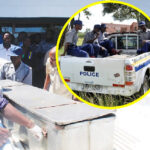The ongoing rescue operation at the abandoned Stilfontein gold mine in North West, South Africa, continues to unfold slowly, revealing a complex and dangerous situation deep underground.
The situation at the mine has been alarming since 18 August, when a total of 1,259 illegal miners have reportedly resurfaced. Among these, the majority—871—are from Mozambique, while 343 are from Zimbabwe.
The remaining miners include 33 from Lesotho, one from Malawi, and only ten are South Africans. Tragically, one body has been discovered, although its nationality and the time of death are still under investigation.
Wessels Morweng, the North West Community Safety and Transport Management MEC, provided insights into the operation aimed at assisting the miners. He revealed that the second phase of the operation took place over the weekend, employing advanced machinery and equipment, including cameras, to assess the mine shaft’s conditions. This involved gathering critical data about methane gas levels and the overall safety of the environment for the miners.
Morweng shared a concerning note received from underground, which indicated that approximately 500 illegal miners were still trapped, with around 300 suffering from illness and requesting additional food supplies. “On Friday, a note from underground mentioned about 500 illegal miners, with 300 unwell, requesting more food,” he said, highlighting the dire situation faced by those still below ground.
The emergence of the miners has been fraught with danger. Morweng reported that some who resurfaced claimed they had been held against their will by armed groups of illegal miners. On 23 November, a group of twelve illegal miners surfaced from the Margaret Shaft, comprising eleven Mozambicans and one Zimbabwean. The following day, another fourteen Mozambicans emerged from Shaft 10, which authorities had previously noted as being flooded. All miners were found to be wet, confirming the presence of water below.
On 25 November, twenty more illegal miners resurfaced at the Margaret Shaft, including fifteen from Lesotho, three from Mozambique, and two from Zimbabwe. This brings the total number of miners who have resurfaced in the last 24 hours to thirty-four, contributing to the fifty-five illegal miners who have emerged since the previous Monday.
General Patrick Asaneng, the North West Deputy Provincial Commissioner, provided updates on the situation. He confirmed that illegal miners still refusing to resurface from the Buffelsfontein Gold Mine had sent out another note requesting more food. “We received a note from the illegal miners on Friday that there are approximately 500 illegal miners underground and 300 of them are unwell,” Asaneng reported.
The response to the crisis has been structured into three phases. General Asaneng explained that the first phase, completed earlier in the week, involved clearing boulders and concrete slabs that had obstructed the shaft entrance. This precaution was vital to prevent any further hazards for the miners still underground.
The second phase, which concluded over the weekend, employed state-of-the-art equipment to assess the mine’s conditions. This assessment focused on the methane gas levels and the overall safety of the miners still trapped inside. “Once all this data has been analysed, we will know when and how to begin with the third phase,” Asaneng said, indicating that the final phase will be a delicate process aimed at ensuring the safe and humane resurfacing of all illegal miners.
According to police spokesperson Brigadier Athlenda Mathe, there are 10 heavily armed Lesotho nationals who are guarding these Zama Zamas and holding them hostage underground.
“here are ten heavily armed Basotho nationals who are guarding them and making them dig for gold,” she stated.
These guards are reportedly confiscating food and water supplies, forcing the miners to work for their basic needs.
Newzroom Afrika conducted interviews with some of the miners as they were being detained by police. One miner shared his harrowing experience, stating he had been underground since July 20.
“I was approached in Diepsloot and told there’s work for us here. I headed underground but the food ran out soon after my arrival and there was no money coming my way. I managed to escape and I’m grateful to the police for helping us,” he said.
His relief was palpable, but he expressed concern for those still trapped below. “I hope they can also help others who are down there and facing hunger. There’s no food down there and people are being beaten. It’s tough down there.”
Another miner recounted his harrowing journey from Soweto, where he was coerced at gunpoint into joining the ranks of zama zamas underground. He revealed that supplies sent down in recent weeks had not reached most of the group, instead being seized by armed overseers.
“They ration the supplies sent down and give us a cup of Mageu [fermented maize meal drink] each per day,” he explained, painting a grim picture of life underground.
The police have consistently maintained that the miners are not trapped but are choosing not to resurface to avoid arrest. This stance was reinforced by a recent ruling from the Pretoria High Court, which dismissed an application from the Society for the Protection of our Constitution. This society sought to allow humanitarian aid and non-emergency personnel to descend into the 2km-deep shaft to assist the miners.











